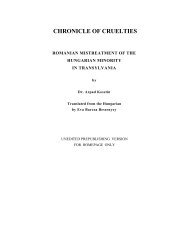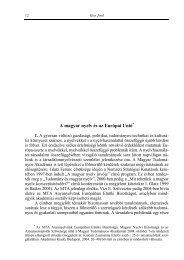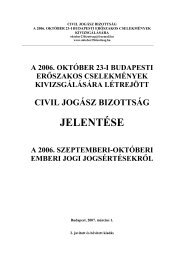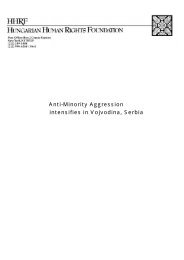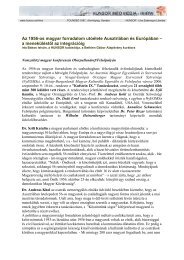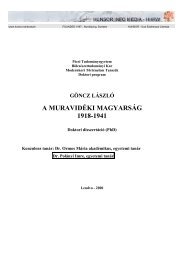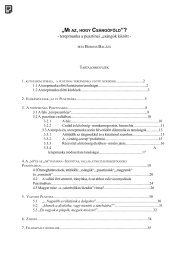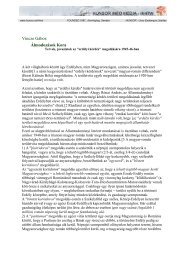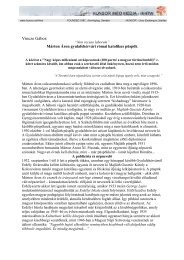piece of land, there are three rows of mass graves of twenty by twenty meters each. They musthave been dug by those who followed, when the enormous pit was full. The partisans tried tomask the noise of the guns and the death cries by sounding the air raid siren. Without guns, itwas impossible for the Hungarians to help their family and friends or fellow Hungarians. Theneighborhood counts five mass grave sites.According to some, there were two thousand Hungarians from Szabadka to have beeninterred beside the old hospital. According to the Priest as many as seven thousand were slain.It is generally known in Szabadka that the executions were led by Strazsakovics Blasko.He is responsible for the death of those massacred innocently.The writer Karoly Dudas and the film maker Zoltan Siflis asked Strazsakovics Blasko tobe interviewed before a camera. Blasko, to mitigate his past crimes, was willing to show his faceand answer questions directly.124Many still believe that he was at the time the military commander in Szabadka, master oflife and death. In fact he was the commissar of the police that had just come into being. As acommissar, he was subordinate to the police commander and his deputy. It is true that his wordalways decided matters.Eugene Nyaradi the police commander, had a Rusyn conscience despite his Hungarianname. His deputy was Tomilica. As a member of the committee for the liberation of the people,he was charged with the task directly by General Ivan Rukovina and Major Pavle Gerencsevics.Their headquarters were the previously mentioned hated and much feared Yellow House.Strazsakovics held the OZNA responsible for the unlawful acts. He, the politicalcommissar of the local police said that he was uninformed of the activities of the OZNA. Hesaid that he did not even know the names of the people involved.Strazsakovics gives the following explanation of his last knowledge of the mass death of theHungarians:"One morning I was going to my office, and I heard loud noise in the building. The guardsaluted and I asked him why all the noise. He said the arrested people were being noisy. I madehim open the door of the hall. As the door opened, the people began to swarm towards meshouting; "Blasko, Blasko, Balazs, help."; all of them wanted to talk to me at once. I knew manyof them, and many of them knew me. There and then I let all go free without asking thecommanders for permission. Later Eugene Nyaradi came up to me saying, "Blasko, why did youlet those people go?" I said to him "They committed no political crime. There was among thereleased Hungarians Anti Odor, commander of a Battalion under the Hungarian Commune. in1919. You were not from here, you can't know these people." He was younger than me, hardlytwenty two; I was thirty at the time. "Most these people would have said in 1941 `you bloodySerb` or `stop kidding me you lingo tongue` as some said such things to me too. We were not todeal with such people.Not much later the town commander, Milos Tadijin, sent for me; he had a colonel calledJovanovics with him. They asked me why I let the enemy go free, when there were some amongthem who had been bemedaled by the Hungarians in World War I. "What do you want", I said,"you could get such medals for a sip of whisky. My father had a sackful of them up in the attic."
"I must have let about seventy people go. Who rounded up these people? A studentcalled Mile, who arbitrarily named himself police commander of a district. He went from houseto house,125questioned people, and arrested some. Well, I punished this student."Now, about the executions. It happened just before the introduction of the militaryadministration. One night I was going home to my parents' house. It was dark, like inside a sack.When I got to the second district, in front of the church, a truck drove past. The only thing Icould make out was that there were people on it. At the corner I also saw that they wereaccompanied by others wearing guns. As I got home and opened the gate I heardtratratratratratra...and I heard the moaning. I was horrified and said to myself, excuse the word,"you mother fuckers, you murderers.""The following day I met the deputy of the military commander, Matija Poljakovics, andI told him what I had seen. He told me that was the way things are, that there were a lot of peoplearrested and there still would be.""Now a few words about how they rounded up the people. There was a Serb here calledFranje Pujindzsics, we only called him Farsa. He was a nice, liberal thinking man. He wassincerely happy about the fall of Fascism and the liberation. At the time, I was already thecommissar of the military command. Poljakovics was telling me that Farsa's wife wasdesperately looking for her husband, she wondered if we had sent him somewhere. I madeinquiries and sent her to Lajos Jaramazovics, president of the local liberating committee.Jaramazovics came to me with her, said I was on the military staff, but we could get noinformation. I made inquiries with the officers of OZNA, who I only knew by the names Milos,Uros, Vanja and Csapo. At last Poljakovics got the information that Farsa had information abouta Croat. He reported that he hobnobbed too much with the Croatian Fascists. <strong>This</strong> man reportedFarsa, so there would not be any witnesses and Farsa was eliminated"."I do not know how severe the reprisal was, but I am sorry it happened. I am sorry we didthe same as Horthy's Fascists. I am sorry it was a reprisal, although the military court alreadyexisted and it should have happened through those channels. Many became victims; there weresurely some who were guilty but not so much as to deserve death. Those who survived these firstmonths, later got away with a few months in prison.""The OZNA kept twenty-five workers here; these were mostly privates from the country.The people from Szabadka knew me and thought that I was fully involved. I only put one personto death, because he had killed and robbed a lonely woman. The victim happened to be aHungarian the criminal a Serbian. The126woman hid this Serbian, who was an army deserter."It is not a secret that, behind the cemetery, where the Mackovics brick factory oncestood, there is a mass grave. We used to organize sports events there, later it was closed. Afterthe war, Tito visited Szabadka. He gave a long speech here and in the introduction he saidsomething hardly anyone understood; I understood. He said:"You have done some cleaning up here; now you'll have to go on working."
- Page 3 and 4:
Library of Congress Catalogue Card
- Page 5 and 6:
Mutilation of the hands or feet wit
- Page 7 and 8:
they wanted to belong. On the annex
- Page 9 and 10:
individuals, then shooting them by
- Page 11 and 12:
the Russians and under their protec
- Page 13 and 14:
22PEOPLE OF BEZDAN1.On a May aftern
- Page 16 and 17:
26that those people all fell victim
- Page 18 and 19:
ack a 13 year-old boy to the soccer
- Page 20 and 21:
Russian officers cursed and told th
- Page 22 and 23:
Jani was set free for he had been a
- Page 24 and 25:
There were some people who, in spit
- Page 26 and 27:
March 12, 1945. The relatives of th
- Page 28 and 29:
Ferenc Csapo, 33 Mihaly Miovacs, 18
- Page 30 and 31:
Having heard about the advance of t
- Page 32 and 33:
"On November 3, I got up at five in
- Page 34 and 35:
The vicar would come every night. H
- Page 36 and 37:
hand. Raising it to his mouth, he d
- Page 38 and 39:
"24th October, 1944. Yesterday was
- Page 40 and 41:
"I have only one chance to be sacri
- Page 42 and 43: The data, which shows that on the s
- Page 44 and 45: all the captured Serbs, as neither
- Page 46 and 47: Before and during World War II, the
- Page 48 and 49: would order fire in an instant. Wit
- Page 50 and 51: Our house looked out over the main
- Page 52 and 53: He had just arrived home after thre
- Page 54 and 55: 28. Jozsef Pasztor, 34 56. Albert G
- Page 56 and 57: The OZNA officer, who exhumed a mas
- Page 58 and 59: 7917 year old Karoly and 8 year old
- Page 60 and 61: 82FROM SZENTFULOP TO THE GAKOVA CAM
- Page 62 and 63: My mother died on January 4, 1946.
- Page 64 and 65: Jozsi, the leader of our committee
- Page 66 and 67: his own grave, then machine gunned
- Page 68 and 69: driving a wheelbarrow on the sidewa
- Page 70 and 71: "Now that's exactly what we needed
- Page 72 and 73: 15 Istvan Polyakovics, Zenta, 18861
- Page 74 and 75: idge was built (from several rows o
- Page 76 and 77: There is a common opinion among the
- Page 78 and 79: The Catholics of the village were o
- Page 80 and 81: and their supporters. On one occasi
- Page 82 and 83: "My younger brother, Bandi, was tak
- Page 84 and 85: two young instructors staying in he
- Page 86 and 87: In Tunderes (Vilova) there was no o
- Page 88 and 89: weeks spent starving, laying on str
- Page 90 and 91: 121PACSERAt Pacser sixteen Serbians
- Page 94 and 95: "I understood that through the OZNA
- Page 96 and 97: took the priest under their protect
- Page 98 and 99: "We set off from Hadikliget on Octo
- Page 100 and 101: everyone to the front! The Party us
- Page 102 and 103: 137REPORT OF LOSSESIn addition to o
- Page 104 and 105: 141Source: Zlocini okupatora u Vojv
- Page 106 and 107: well as in words, that there had be
- Page 108 and 109: The American military forces delive
- Page 110 and 111: culpability or participation are th
- Page 112 and 113: The accused did not make use of his
- Page 114 and 115: the spirit of revenge among the Hun
- Page 116 and 117: considered all the claims of Hungar
- Page 118 and 119: The People's Court of Budapest just
- Page 120 and 121: From then on all hell breaks loose.
- Page 122 and 123: Recommended readingeRudolf Kiszlion



